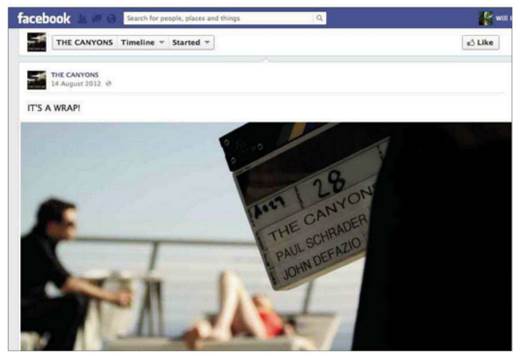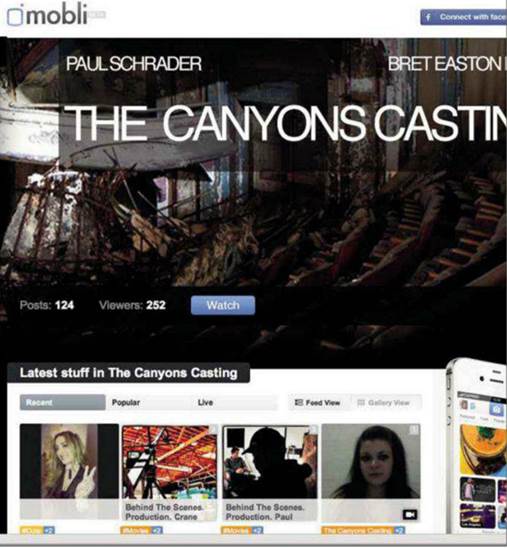How social networks freed The Canyons
from big-studio shackles
Digital technology has revolutionized
filmmaking: what used to be an expensive process, out of reach of all but a few
has become available to most people, no matter what their budget. Most mobile
phones can film HD footage and DSLR cameras can capture footage that’s being
used in film and high-end television productions.
Technology hasn’t just changed how films
are made, though: it has also changed how they’re funded. Hollywood
blockbusters still have $100 million budgets, but thanks to the internet, it’s
possible to put a film together for much less. Sites such as Kicstarter have
made it possible for people who wouldn’t have been able to make a film via the
Hollywood route to gain funding.

Videography
Canyons - Going It Alone
The Film and Video category on Kickstarter
has the largest number of projects on the site. However, while unknown and
first-time filmmakers using Kickstarter to fund their projects is nothing new,
the approach has now caught the eye of established Hollywood players.
While Hollywood financing provides huge
production budgets, this money doesn’t come without strings attached. The
writer and director may set out with a certain vision of how the film will pan
out, but commercial influences further up the chain may prevent them from fulfilling
this exactly as they’d envisioned. This could be pressure to remove material to
receive a lower film classification, and so a larger audience, or to change to
story entirely to make it more commercially appealing – adding a happy adding
to a tragedy, for example, or not killing off a major character to increase
sequel potential.
Without a studio to call the shots,
filmmakers can create the film they want, rather than one paid for and sculpted
by the series of accountants to maximize potential revenue. Which is exactly
what Paul Schrader, Bret Easton Ellis and Braxton Pope set out to do with their
film The Canyons.
Schrader wrote the scripts for Taxi Driver
and Raging Bull before going on to direct with films such as American Gigolo.
Bret Easton Ellis wrote the books American Psycho and The Rules of Attraction,
which were made into movies. Braxton Pope has produced a number of Hollywood
films and has co-founded a production company with Easton Ellis.
In late 2011, Schrader had been due to
start shooting an original screenplay by Easton Ellis, but the funding fell
through. Schrader emailed Easton Ellis to explain the situation, but also
proposed they work on something else. ‘Perhaps a section of one of the books or
a new bit mixing some characters’, Schrader wrote. ‘Given the new economics of
filmmaking, I envision this as a relatively micro-budget production’.
Schrader continued: ‘Between the two of us,
we could attract interesting actors and create a profile for the film via
social media. It would be something that we own. We wouldn’t have to go hat in
hand looking for unrealistic financing. And, most importantly, there would be
no censorship’.
The social media profile for the film went
so far that Schrader shared the above email – and Easton Ellis’ response on the
Facebook page for The Canyons at the end of last year. Social media was also
used during casting the movie, and also funding it as well. Frequent updates
were posted during production, including photos form the set that were taken
during filming, enabling the public to see the film as it evolved.

Open
cast: Although actors with previous experience took the main roles, others were
cast through open auditions on online sites such as Mobli
Schrader, Easton Ellis and Pope each put
$30,000 of their own money into the project, which, while enough to just about
make the movie, is peanuts by Hollywood standards. They then setup a
Kickstarter project (kickstarter.com/projects/1094772583/the-canyons) with the
aim of raising an additional $100,000 with the promise that the additional
budget wouldn’t be going into salaries: everyone was paid the $100-a-day
minimum that the unions allow.
Instead, any additional funds would be
spent making eth movie look better. In exchange for backing the film, members
of the public could become part of the production crew, having input on casting
the actors and other aspects of production. And for those backers who were
prepared to part with a few thousand dollars, there were additional benefits on
offer, such as training alongside Easton Ellis and his personal trainer for a
week, or the engraved money clip Robert De Niro gave Schrader on the set of
Taxi Driver.
While $100,000 for a movie isn’t an
enormous amount, it’s still a pretty large number by Kickstarter standards. Of
the 8,500 film and video projects successfully funded on Kickstarter so far,
only 73 have raised more than $100,000 Luckily, the team, the concept and the
additional benefits were enough to persuade 1,050 backers to donate a total of
$159,000, giving the movie a $250,000 budget to play with.
The original plan was to cast the roles
through the online casting sites Let It Cast (letitcast.com) and Mobli
(mobli.com). However, after Lindsay Lohan was asked to take a cameo role, she
decided she wanted the lead. Easton Ellis also pushed for the male lead to go
to porn actor James Deen. Despite taking the lead female role, Lohan would
still get the same $100 per day fee as everyone else, although she will also
get a share of the profits if the film’s a success.
Despite the lead roles going to established
actors (even if one of them was moving over from a different area of film),
other roles were cast through Let It Cast and Mobli. There was also a call for
extras to apply directly via an email address posted on the Facebook page and
Twitter account.

Tweet
news: Social media channels were also used for requests, such as a call for
extras
The film started shooting mid-July last
year, and was wrapped just over a month later, with plenty of progress shots
posted on the Facebook page throughout. The rough cut was completed a week
later and a second cut a week after that. The announcement of each cut was
accompanied by notes from Schrader, giving additional insight into the
filmmaking process.
Music was next, and then teaser trailers
were released in the run-up to Christmas. The original plan was to get the film
into the Sundance Film Festival, but despite it initially looking promising it
was rejected. The pan now, according to a Facebook update by Schrader, is a
limited theatre release followed by digital distribution.
‘In a way, it’s good we’re not at
Sundance’, Schrader wrote. ‘We weren’t prepared, we weren’t organized. Films
enter festivals to heighten their profile. The Canyons doesn’t need to do that.
We need to organize multiplatform distribution. This is not a dodge, its common
sense. The film is very good. I have no qualms about that’. Of course, even a
$250,000 budget is more than many aspiring filmmakers dream of. But if even
seasoned Hollywood players are going down the DIY route, then it shows that if
you have a strong enough idea and desire to produce your own film, it’s much
more possible now.
Star names among the cast help raise the
profile of an indie production, but they’re not essential to the production.
Provided you can convince enough people to back your vision, you can produce a
film on a shoestring budget, cast unknown actors, film it on consumer DSLR
equipment and edit it on a MacBook.
The more money available, the more you can
spend on the final finish and promotion, but astronomical budgets are no longer
necessary if you just want to get something made and distribute it digitally.